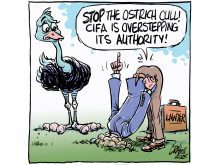Elaine Shein is Producer managing editor.
An ostrich sale was halted recently in Red Deer because no bids drew higher than $50.
On another occasion, an Alberta rancher showed off a pair of what he calls his $40,000 boots. That’s how much he says his ostrich cost when he bought it, but it became boots when he realized he would never recoup his investment.
In Texas a few months earlier, a frustrated ostrich owner was found guilty by the courts of battering several of his ostriches with a baseball bat after he helplessly watched prices plummet.
Read Also

Budget seen as fairly solid, but worrying cracks appear
The reaction from the agriculture industry to prime minister Mark Carney’s first budget handed down November 4th has been largely positive.
Other producers in the U.S. have set their birds free. A few suicide rumors surface occasionally about people who lost their lifetime earnings gambling on raising birds or animals.
Welcome to the world of speculation in exotics, in particular ostriches.
As noted in our Specialty Livestock Producer included in the Dec. 4 issue of our paper, the bubble has burst for ratites.
There remains a dedicated few who will keep their birds and continue to work hard to develop processors and markets. Eventually, they may find their supportive niche of consumers.
But there is still considerable work to be done.
Few members of the public have tried ostrich meat, and even fewer commit to seeking it again.
They seem aware the meat is touted as healthy and very lean, but often they also note their sample was too dry, too expensive or too difficult to find for a second test.
Often it’s compared to beef, raising the expectation of ostrich meat being as tasty, as available and as price-competitive as beef.
However, few people think of throwing a few ostrich steaks on the barbecue.
Few conjure up images of roast ostrich for Christmas.
And the romantic anniversary dinner still doesn’t whet the appetite for ostrich.
Beef and other meats have also experienced growing pains as people needed to learn how to cook the meat properly, taste it several times, and discover there can be tough as well as tender cuts.
So what needs to be done to save the ostriches and other exotics from oblivion (home to other popular investments such as the Pet Rock and Rubik’s Cube)?
First a dose of reality on prices at the farmgate as well as the dinner plate.
While high-quality breeding stock can and should command respectable dollars, the number of animals needed is not infinite. Before spending big dollars, think realistically whether and when that critter will return any value on the investment as a product other than just breeding stock.
If you can’t afford to lose that original investment, you probably can’t afford to play the game.
Also, the price of meat must be tolerable for consumers and compete with other high-quality meats.
Next, ensure the meat quality being tested in restaurants and by consumers is high. If the first bite is dry, there won’t be a second nibble.
Finally, nurture the exotics in the farm pen as well as the marketplace, rather than treatig them as a “diversified investment portfolio.” Neither side benefits with that attitude.














